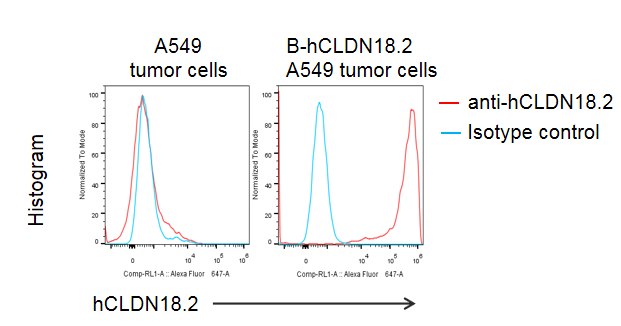|
Common name |
B-hCLDN18.2 A549 | Catalog number | 310791 |
| Aliases | OASFTA5, SFTPJ | Disease | Carcinoma |
|
Organism |
Human | Strain | -- |
| Tissue types | Lung | Tissue | Lung |
Description
The human CLDN18.2 coding sequence was inserted into the AAVS1 locus in A549 cells. Human CLDN18.2 is highly expressed on the surface of B-hCLDN18.2 A549 cells.
Application
B-hCLDN18.2 A549 cells have the capability to establish tumors in vivo and can be used for efficacy studies.
Targeting strategy
Gene targeting strategy for B-hCLDN18.2 A549 cells. The exogenous promoter and human CLDN18.2 coding sequence was inserted into the AAVS1 locus wild-type A549.

Tumor growth curve & Body weight changes


B-hCLDN18.2 A549 cells (1x107) and wild-type A549 cells (1x107) were subcutaneously transplanted into B-NDG mice (n=5), and on 45 days post inoculation, tumor cells were harvested and assessed for human CLDN18.2 expression by flow cytometry. As shown, human CLDN18.2 was highly expressed on the surface of B-hCLDN18.2 A549 tumor cells. Therefore, B-hCLDN18.2 A549 cells can be used for in vivo efficacy studies of novel CLDN18.2 therapeutics.

Antitumor activity of anti-hCLDN18.2 antibodies in CB-17 SCID mice. (A) Anti hCLDN18.2 antibody slightly inhibited A549-hCLDN18.2 tumor growth in CB-17 SCID mice. B-CAG-hCLDN18.2 A549 cells were subcutaneously implanted into CB-17 SCID mice (female, 7 week-old, n=5). Mice were grouped when tumor volume reached approximately 90 mm3, at which time they were treated with anti-hCLDN18.2 antibody with different doses and schedules indicated in panel (B) Body weight changes during treatment. As shown in panel A, anti-hCLDN18.2 antibody was efficacious but mild, demonstrating that B-CAG-hCLDN18.2 A549 cells can be used to establish tumor model and provide a powerful preclinical model for in vivo evaluation of anti-hCLDN18.2 antibodies. Values are expressed as mean ± SEM.








